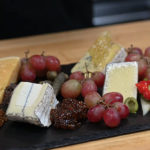
You’ve probably looked at ingredient labels on food and wondered what some of those words mean. Maybe you’ve even heard the advice to never eat what you can’t pronounce or that chemicals don’t belong in food.
But is that really true? Would you worry if you saw dihydrogen monoxide on a label instead of water? We’re clearing up some of the mysteries behind common food additives and helping you understand what they’re doing in food. Let’s start by looking at the different categories of food additives.
Anticaking agents are often added to dry foods, such as salt and baking powder, to keep them flowing freely; common ones include silicon dioxide and calcium chloride.
Have you wondered how breads and baked goods maintain their stability and structure? They have dough strengtheners and conditioners. On labels, you might see sodium metabisulfite or ascorbic acid.
Have you noticed that some salad dressings need less shaking than others? That’s because of emulsifiers, such as soy lecithin or mono- and diglycerides.
Fat replacers are sometimes added to fat-free or reduced-fat foods to give them the creamy texture associated with fat. Xanthan gum, modified food starch, and other fat replacers show up in baked goods, frozen desserts, dressings, and dairy products.
Glycerin and sorbitol are humectants, added to foods in order to retain moisture. They keep soft candies and marshmallows pliable and prevent shredded coconut from drying out.
Leavening agents are added to foods to promote baked goods to rise. On labels, they include fumaric acid and sodium bicarbonate.
Natural and artificial colorings are added to foods to offset color loss because of storage conditions (e.g., light and heat), to correct variations in colors, and to provide color to colorless foods. The U.S. Food and Drug Administration (FDA) has approved these for use in food; they’re found most commonly in beverages, cereals, frozen dairy desserts, frostings, and snack foods.
Natural or artificial flavoring and spices are added to foods to impart a specific flavor or enhance flavors that are already part of the food. We’re careful to identify these for community members, as they may contain allergens, such as mustard or sesame.
Nutrients are added to foods whenever vitamins and minerals are lost through processing or when specific nutrients are found to be lacking in the diet. Products using these will be labeled as fortified or enriched. They’re commonly found in breads, cereals, and milk.
Preservatives are added to prevent food from spoiling; to maintain the color, flavor, or texture of food; and to keep food fresh. They help extend shelf life and are in everything from cereals to meats and prepared fruits and vegetables.
Stabilizers, thickeners, binders, and texturizers are added to foods in order to produce a pleasant texture. They include guar gum and carrageenan, and you’ll find them mostly in frozen desserts, dairy products, and baked goods.
Sweeteners are added to sweeten food and can be natural or artificial, like fructose or sorbitol.
You may have seen the term “GRAS.” This stands for Generally Recognized as Safe and is a designation that the FDA gives to food additives. There are two ways for an additive to achieve GRAS status. The first is historical — if the additive was used before 1958 and has a history of consumption by a significant number of consumers, it’s GRAS.
The second is through scientific exploration. Data and information about the use of the additive must be shared, and qualified experts determine whether it’s safe for its intended use. That data and all relevant studies are then sent to the FDA to review and decide whether the additive will be considered GRAS. GRAS status is public, and you can find the list of approved additives on the FDA website.
Either way, all additives have been approved in some way before they’re used in any product available in the marketplace.
At SAGE, we focus on scratch cooking, which allows us to control our ingredients and provide clear, easy-to-understand ingredient lists. Our team of Registered Dietitians reviews all our ingredients to ensure they meet our standards and are accurately tagged for allergens.
There’s no shortage of additives in food, because they serve so many different purposes. If you’re interested in learning more, visit sagedining.com/blog and look for our series about food additives from A to Z, which will clear up confusion about some of the most common ones.



